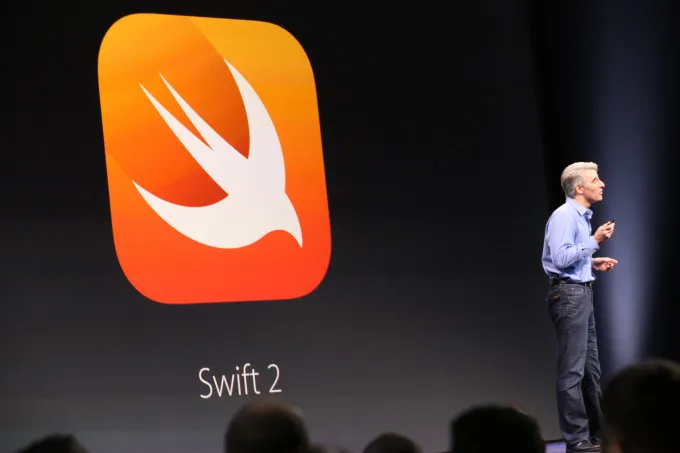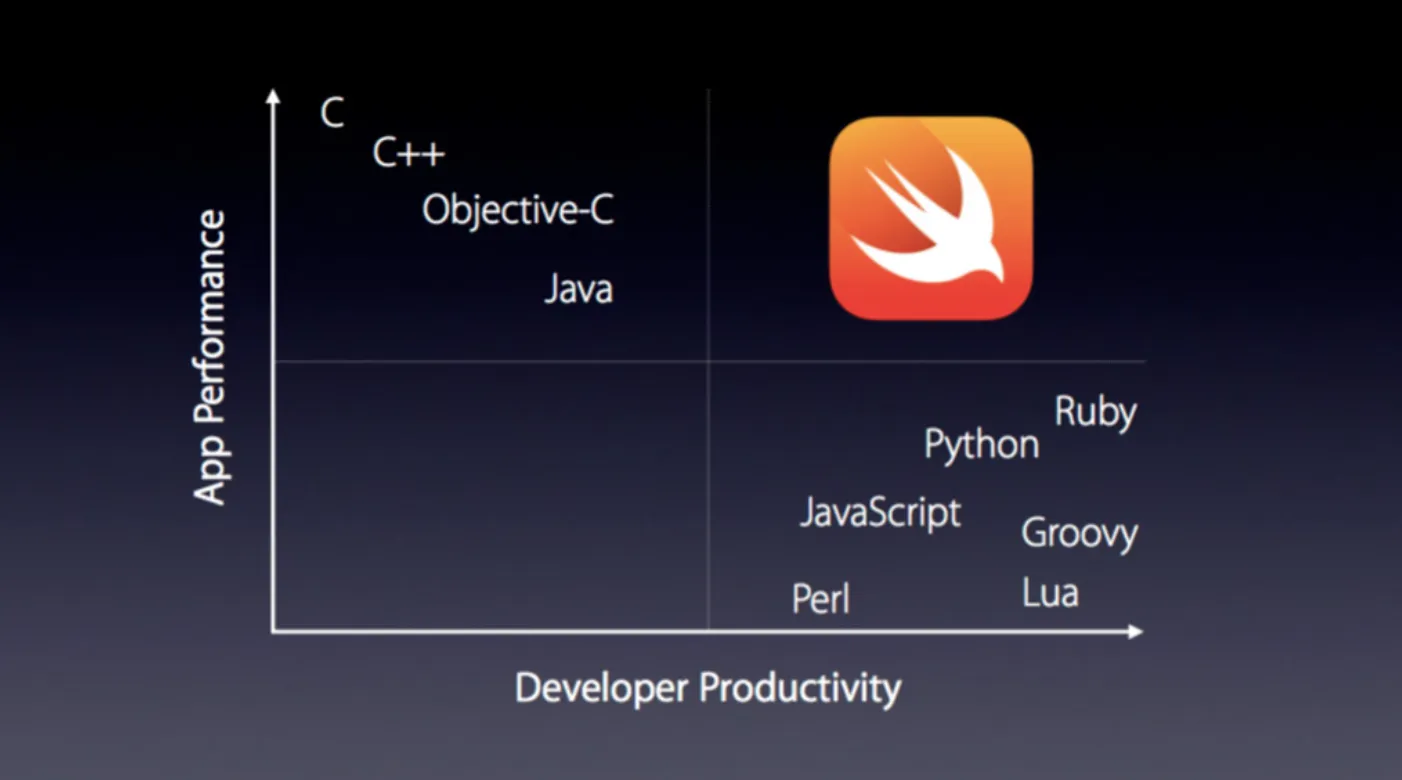Swift Programming Language


Swift programming language has cracked the top 10 in recently released rankings of most preferred languages among developers, causing a dramatic increase in popularity!
Developed for around 4 years in complete secrecy, nobody knew about Swift outside of Apple.
So what is Swift and what makes it so popular?
Well, Swift is the most fantastic programming language to write software. No matter if you want this software for desktops, smartphones, servers or any other platform that runs the code. It is fast, safe and an absolutely interactive programming language. It is best known for combining the best of modern language thinking (along with wisdom from Apple’s wider engineering culture) and its open-source community’s diverse contributions.

Today, Swift is the latest programming language that has hit the developer scene. The language was developed in 2014 by Apple but its code was open-sourced in December – 2015 to achieve greater adoption. If you are a business leader, it’s no surprise that you might have ignored Swift. After all, you are not expected to recognize development languages.
Indeed, there are numerous reasons why the management of growing organizations must care about Swift while following their progress. In fact, there are many big names that have already been making the most of this competitive and flexible programming language. Among them:
- Pandora
- Square
- 9GAG
- Hubspot
- Apple
- Weebly
- Lyft
- OpenTable
- Thoughtbot and others
Apart from these, there are 750+ organizations that have successfully adopted Swift for writing software, all around the globe!
Swift – The Right Tech Stack for Your Product
If you are wondering if more businesses or companies will integrate Swift as the time goes on, then the answer is yes!
Today, Swift is 5 years old. However, most of the languages which are still in use for production are around 10 years old, including some over 20 years old. During that time, there have been several helpful tools and libraries written for all these languages. Similarly, libraries will also emerge for Swift and the flexibility of this language will be looked upon by businesses with a much higher opinion. In brief, it is already in the process of becoming one of the most viable options.
With 1 billion + devices being in use, iOS has now become the 2nd most popular mobile platform. However, in some regions including the UK, France, and the USA, Apple devices are constantly outperforming Android platform. This is one of the primary reasons why many businesses are now focusing their software products majorly and sometimes only on the iOS platform.
It is now being considered as the strategic benefit and key investment opportunity for business leaders!
Any smart business owner, who follows an iOS development path, will certainly focus on selecting the right tech stack for their product. So if you’ve decided to choose native development than cross-platform solutions, it’s time to decide the language i.e. either old Objective-C or the latest popular Swift.
Some Popular Facts about Swift:
Here are some of the most popular facts about Swift that makes it the most preferred choice of today’s business industry!
- It combines the best components of Objective C and without any compatibility constraints while providing new features.
- The language can be used for all products with OSX 10.9 and iOS7
- Swift support different and modern programming language such as Closures with Function Pointers, functional as well as generics programming patterns.
- It offers better memory management, safety and comes with built-in support to check API availability.
- The programming language provides support for 3 access control levels in terms of symbols: internal, public and private while another new and important attribute in Swift is ‘option types’.

From the new programmer’s point of view, Swift is a friendly programming language. It is an industrial-quality language that is as enjoyable and expressive as a scripting language. When your programmer writes Swift code in a playground, it allows them to experiment with the code and observe results immediately. This is possible even without the overhead of developing and running an app.
Its code is designed and optimized with the aim of obtaining most of today’s modern hardware. The great combination of speed and safety makes Swift a great choice for everything including an entire operating system. It combines powerful inference type and pattern matching with a lightweight modern syntax that allows the expression of complex ideas in a concise and clear manner.
As of March 2018, Swift is recognized as the 12th most preferred and popular language. It has surpassed Scala, Go, Objective-C and R. it has more than 40,000 stars on GitHub as well as 187,000 StackOverflow questions. Nonetheless, this young and new language has rightfully become the most dominant technologies in today’s industry.
IOS Native Development and Reasons to Use Swift
Swift programming language is considered superior to its predecessor in many aspects.
As per the official PR:
Swift successfully combine the efficiency and performance of compiled languages with the interactivity and simplicity of popular scripting languages.
For now, let’s leave the marketing and technology details aside and look at its importance from a more business perspective.
Fast Development Process
An expressive and clean language with a quite simplified grammar and syntax, Swift is easier to both read and write. It is quite concise i.e. it requires less code to perform the tasks, as compared to other languages like Objective-C. This means that you can easily and instantly start your software development journey.
The management of the app’s memory usage and tracking is done by ARC (Automatic Reference Counting). This means that your developers don’t require spending additional time and effort to perform the task manually. In brief, it takes a lot less time to develop iOS apps by using Swift.
One of the most shining examples of these benefits is the Lyft application. The company successfully re-wrote the iOS app with the help of Swift. While the previous codebases consist of around 75k code lines, the Swift version re-built the similar functionality with almost less than a third of it. As a result, the app now features a new and improved onboarding process.
To your surprise, the old one took multiple engineers and more than a month to implement, whereas the new Swift based on boarding was finished within just a week and with just one engineer.
Improved performance and safety
As the name suggests, Swift is supposed to be fast. The language is developed with a great focus on speed and performance and was designed to smash its predecessors. With just the initial release, the businesses observed 40% increases in terms of performance, in comparison to Objective-C.
In fact, over the years, this has been proved by multiple tests and benchmarks conducted by different developers. Not to mention, the Swift code gives your developer great feasibility to optimize it in many ways for better performance.
Another great strength of Swift is its safety. Its powerful and strong error handling and typing system prevent code crashing and production errors. Swift comprise of a shorter feedback loop that allows you to observe code errors instantly and to resolve them on the fly. This greatly reduces the effort and time required for fixing the bug and alleviating the risks of deploying poor quality code.
Swift help enterprises to remove the mobile app gap
It is a common observation that when your business wants to build an app, the developers may fail to finish the work within six months time. No doubt, mobile app development skills are frequently expensive and highly sought after. Also, these skills are not the only gating item in terms of enterprise mobility deployment.
Anything that can be done for the improvement of coding talent is crucial. That is why Swift is not only easy to use but also easy to learn. So if you think that you need extra IT staff to fully support mobile app development, Swift is a win for your business.
Moreover, its coding is a lot more streamlined. It is less prone to error, faster to develop and easier to test as a language. To give you an example, City Furniture started with no Swift experience in the delivery of a mobile app within 6 weeks time. Thus, Swift is just one path to kick-start mobile efforts.
Innovation and speed at a lower cost
In today’s competitive business industry, every business needs to move faster and work smarter. Thus, leveraging an open-source community can surely help in scaling innovation while managing costs.
According to business strategist: Github generation (millennial and students) which are likely to be the future workforce of a business must learn to use open source tools. This would serve as the foundation to create IT solutions.
Not to mention, open source is not one and the same as unsupported. So if you are unaware of the open-source trends, you may not be able to assess if your employed IT team is actually using decrepit architecture or leading IT tools to fit the competitive battles. After all, we now live in a competitive business industry where business leaders have to be technology literate similarly technologies need to understand the business to select accurate tools.
Swift and the iOS Development Future
Despite the tender age and recent popularity, Swift continues to achieve a number of well-known success stories. Isn’t it easy to understand when we see that LinkedIn, Lyft, Vimeo, Fitbit, Groupon, and Twitter are among the top companies which have chosen Swift language?
Just to mention, Uber and Facebook are now also showing great interest in Swift!
Swift is definitely considered revolutionary, even though most of its features have already been done in previous popular languages.
Indeed, the programming language seems to be the most worthy successor to old Objective-C for desktop and mobile application development. Just like its predecessors, Swift is small and articulately designed.
It implements a carefully chosen set of features which contribute to the readable yet concise code.
The future of Swift lies in its ability to distinguish itself as the language with a rich and high-level features-set along with automatic memory management that easily comes down to native code. It doesn’t depend upon garbage collection or VM. Admittedly, this is a narrow niche but a significant one such as software that runs on resource-constrained iOS devices.
Over the last few years, the programming language has received a lot of support from the community to not only grow but to get matured. However, only Apple can know the next plan for Swift language but we cannot ignore the fact that the language is now more mature than ever.
Certainly, developers who created native apps are not likely to abandon Swift any soon as there is no other native app that would offer great performance with excellent flow.
In the bottom line
Will this flexible programming language replace other languages in use out today? Perhaps not. After all, every business and developer has their own preference and need for different tools to perform different jobs. But the best approach is to hire a dedicated team of developers.
Previously there were many examples of an excellent set of tools, but now Swift is the only option considerable in the open-source world. Smart business leaders are not describing the workflows and processes to improve as well as request ‘Art of the Possible’ sessions and examples with their IT team.
Finally, there is no one size fits all strategy to development. The primary focus should be on the experiences you want to create while working with IT to choose only the best technologies on the basis of what you actually want to accomplish.
Conclusively, Swift has spent years in making and is still evolving with new capabilities and features. So if you are also planning to develop a high-performance software or app for your business, you must seek advice or information from expert professionals.
Build your ideal
software today

